Google Calendar integration keeps your work and personal schedules aligned. Appointments created in Trafft appear in Google Calendar, and busy times from Google automatically block availability in Trafft to prevent double bookings. Updates in either system are synced both ways.
Video Version
Activating and Configuring
To enable it, navigate to the Features & Integrations section within Trafft. Locate the “Google Calendar and Google Meet” integration, and activate it with a simple click on the “Enable” button.

Once enabled, the card will refresh to display a “Set Up” button. Click it to access the configuration page for Google Calendar and Google Meet.
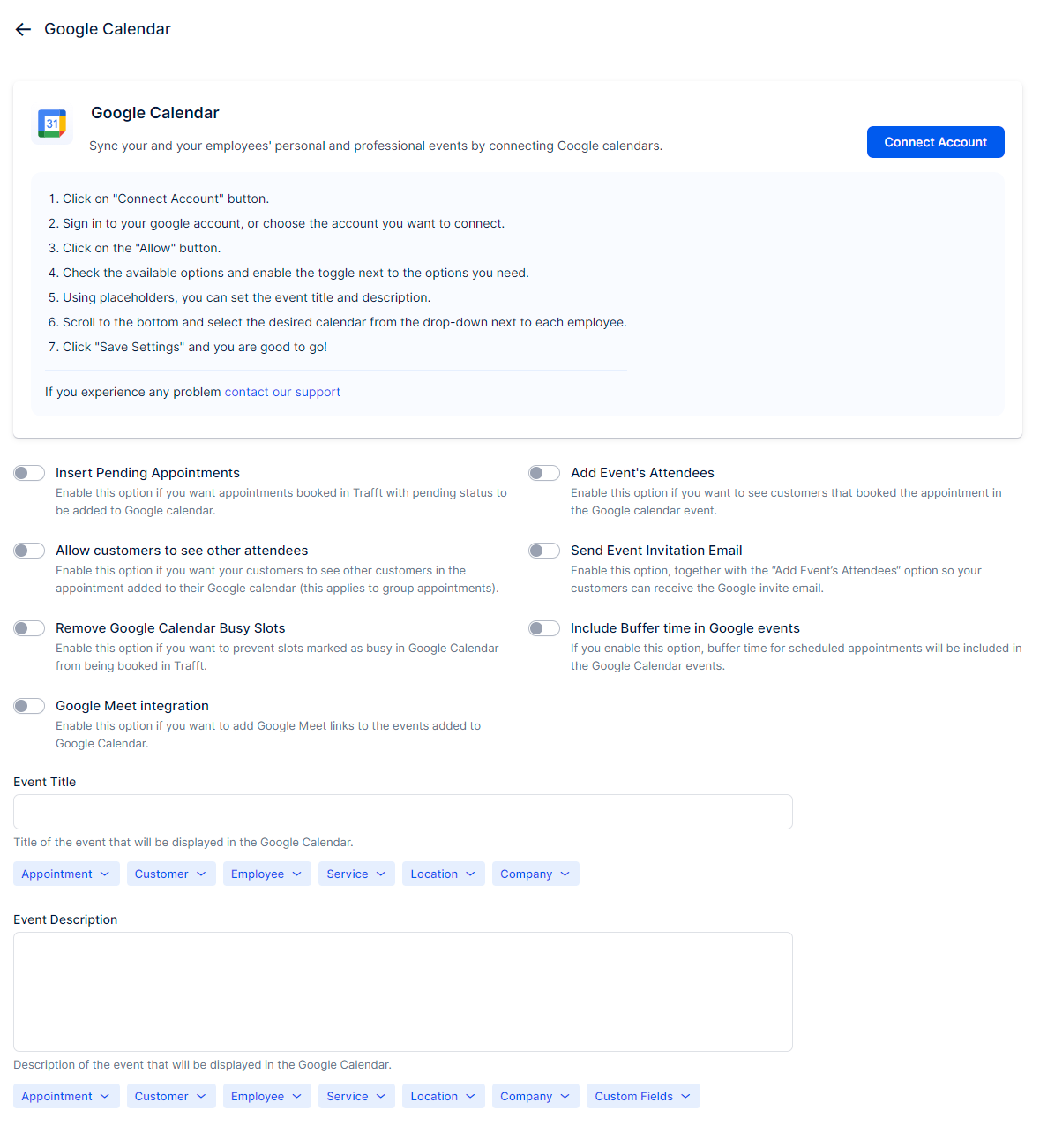
There are two ways to connect:
- Link the Main Account: Connect the admin’s Google account and assign calendars from it to employees.
- Link via Account Settings: Employees connect their own Google accounts through Account Settings. Each employee can link up to 6 accounts and select multiple calendars for blocking availability.
Whichever method you use, calendars can block availability, and one calendar can be chosen to store Trafft appointments. Below are the key settings available:
- Insert Pending Appointments: Adds pending appointments (not approved yet) to the calendar.
- Add Event's Attendees: Adds all booked customers to the Google Calendar event, useful for group appointments.
- Allow customers to see other attendees: Lets customers see who else booked the same group appointment. Disabled by default for privacy.
- Send Event Invitation Email: Sends a Google invite email in addition to Trafft’s notifications.
- Remove Google Calendar Busy Slots: Blocks slots marked as busy in Google Calendar to prevent double bookings.
- Include Buffer time in Google Events: Adds buffer time to events shown in Google Calendar (optional).
- Google Meet Integration: Adds a Google Meet link to appointments if enabled.
Event Title and Event Description
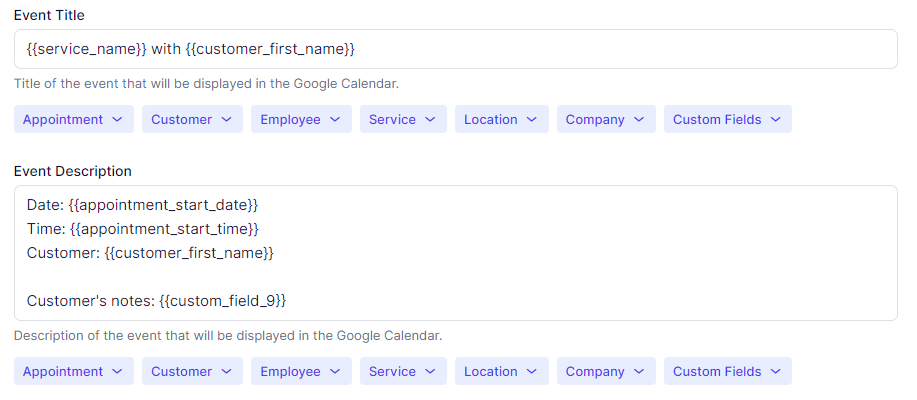
Customize what appears in Google Calendar events created from Trafft appointments using text and placeholders like {{service_name}}. Event title defaults to the service name; description is blank by default.
- Event Title: Place your cursor inside the "Event Title" field. Then, choose from the dropdown menu below the field to select the information you want to display in the Event title. By default, the {{service_name}} placeholder is added to the title but you can write custom text and include other placeholders if you want.
- Event Description: Similarly, you can customize the "Event Description" field. Place your cursor inside this field and select the desired information from the dropdown menu to include in the Event description. By default, the Event Description field is blank, allowing you to add specific details as needed.
Placeholders allow you to dynamically insert information into the Event title and description. By utilizing them, you can create customized and informative Event titles and descriptions that provide important details at a glance.
Linking the Main Account
Best for businesses where all employee calendars are managed in one Google account. After connecting the admin’s account, employees appear in the list and you can assign them calendars.
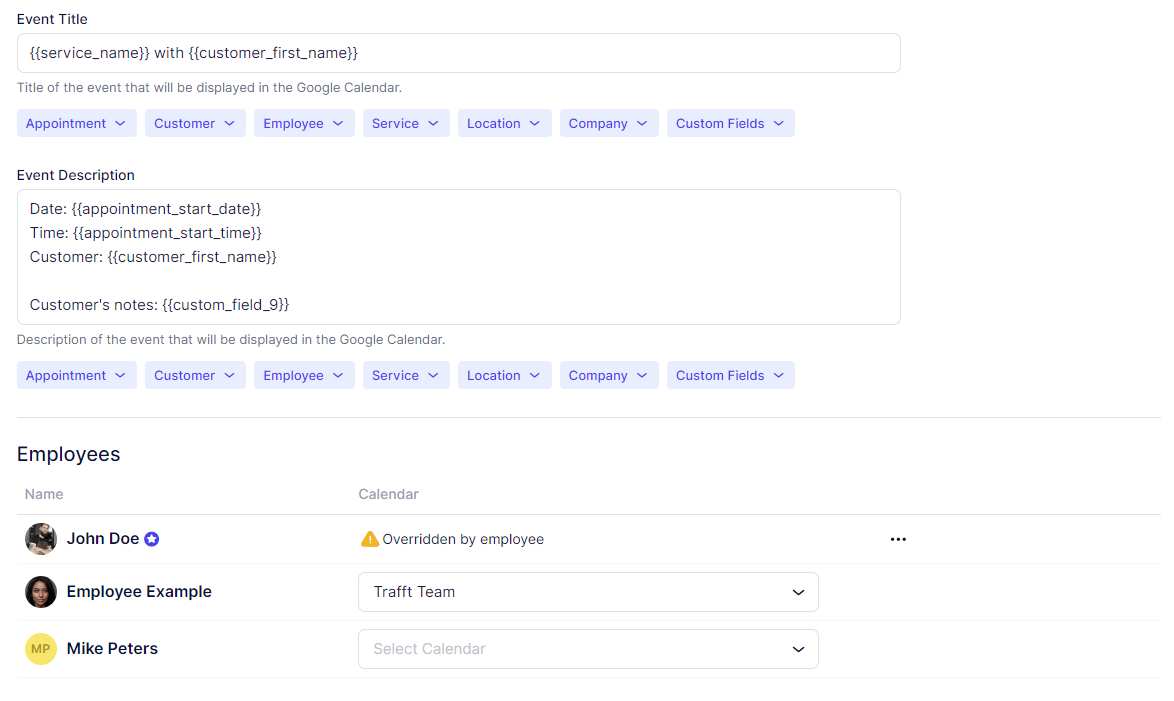
The screenshot above shows three different options related to employee's connection with Google Calendar.
- "Mike Peters" currently isn't connected to any Google accounts;
- "Employee Example" is connected through the Google Calendar integration page;
- "John Doe" is connected to his personal calendar through Account Settings.
By default, once the account is linked, all employees will appear below the Event Title and the Event Description with a blank dropdown menu, like "Mike Peters" in the screenshot above.
If you choose to assign a calendar to an employee, the dropdown will expand and pull all the calendars you have created in the Google Account you previously linked with Trafft. Assigning one of those calendars to an employee is showcased by the employee "Employee Example" in the screenshot above. Once an employee is linked in here, they won't be able to link their personal Google accounts through Account Settings/Integrations, and they would see the following notification if they were to access this section:
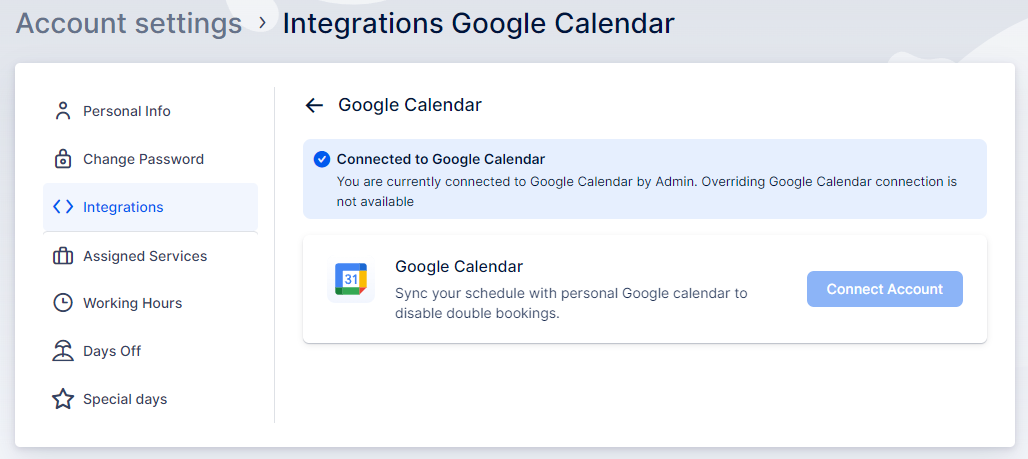
When an employee is assigned a calendar through Features & Integrations, they cannot connect their own Google account from Account Settings. If the employee needs to connect their own account, the admin must remove the assigned calendar first by clicking the “X” next to their name and saving.
Allowing the employee to log into their calendar ("John Doe" in the screenshot above) basically covers Linking via Account Settings, so please continue reading to see how this is done.
Linking via Account Settings
Employees can also connect their own calendars directly in Account Settings. This is useful when they manage multiple calendars or prefer not to use an admin-assigned calendar.
If you see “Overridden by employee” next to a name in Features & Integrations, it means the employee connected their account themselves. Admins cannot assign calendars in this case unless the employee disconnects their personal integration first.
To enable employees to log into their accounts on Trafft, follow these steps:
- Go to Settings > Users and Roles > Users
- Find the employee, open the menu next to their name, and select Enable Login
- Set or generate their password and send them the login detailsThe same can be achieved from the Employee tab
Once they log in, they can connect their Google account under Account Settings > Integrations > Google Calendar.
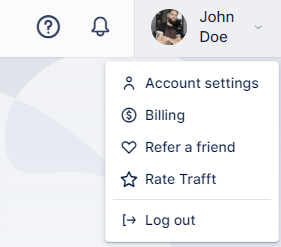
This will open a new window where the logged-in employee can update their personal information, change their password, and manage their schedule (if their user role allows). Most importantly for this integration, they can access the Integrations section and log into their personal Google account.
Once the Integration section is accessed, click on "Google Calendar".
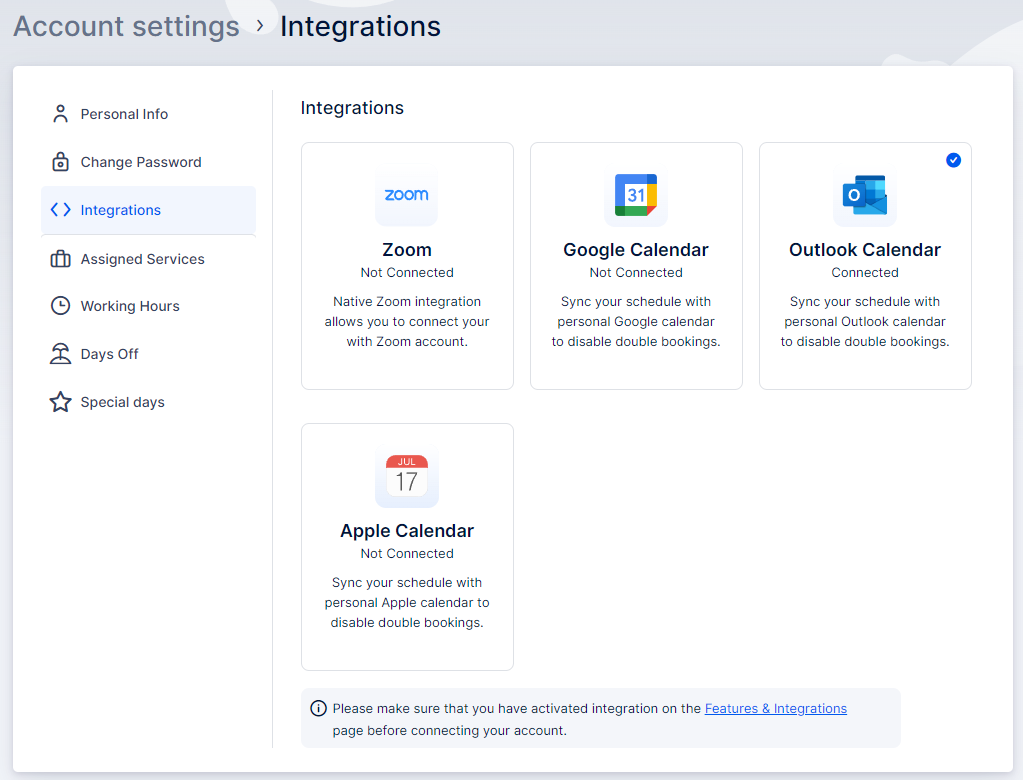
In there, click on "Connect Account" and Trafft will redirect you to Google's log-in page where a Google account needs to be selected. After this, Google will also warn you that you're allowing Trafft to view and edit events on all your calendars (calendars created in the account you're logging into) and to see and download any calendar you can access using your Google Calendar.
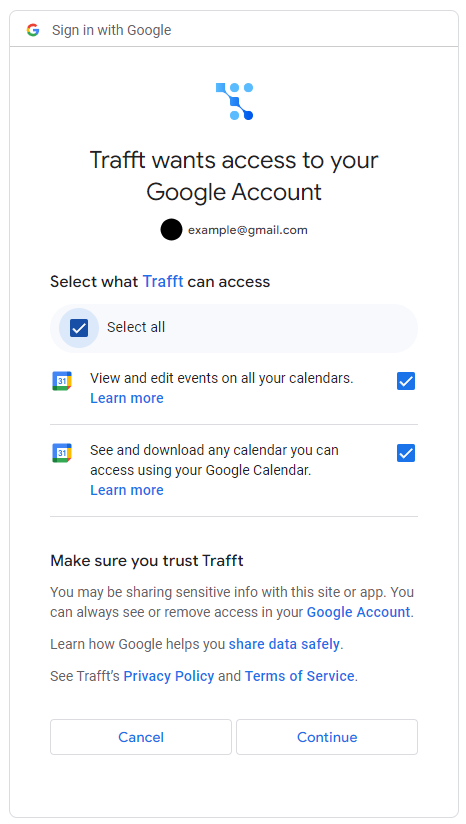
For the Google Calendar integration to work, you need to select both permissions and click on Continue, as shown in the screenshot above.
Once Trafft is allowed to access the Google account, you'll be brought back to the Account Settings/Integrations page where you'll see that your account is now connected. Showcased in the screenshot below, you will be able to:
- Add Another Account - One employee can add multiple accounts to be able to select calendars that are supposed to block times in Trafft. The maximum number of accounts that can be added is six.
- Sync with - Choose one of the connected calendars where all scheduled appointments from Trafft will be added. You can only select one account for this option.
- Block time from calendars - Select multiple calendars from which busy time slots will be blocked off in Trafft. You can add a maximum of six accounts by clicking "Add Calendar". For instance, if you have a business calendar and a private calendar, adding both here will make all busy time slots in both calendars unavailable in Trafft.
- Insert Pending Appointments - by default, once the employee links their Google account, the default settings made in the Google Calendar and Google Meet integration page will not be pulled, so the employee needs to choose whether they'll include Pending appointments made in Trafft in their Google Calendar.
- Include Buffer time in Google events - similarly, this option is not inherited from Google Calendar global settings, so the employee can choose whether they want buffer time added to the events created by Trafft or not.
- Event Title and Event Description - as you can see, this option also doesn't pull the setup from the global settings, so the employee will need to populate the Event Title and the Event Description here.
- Don't forget to save!
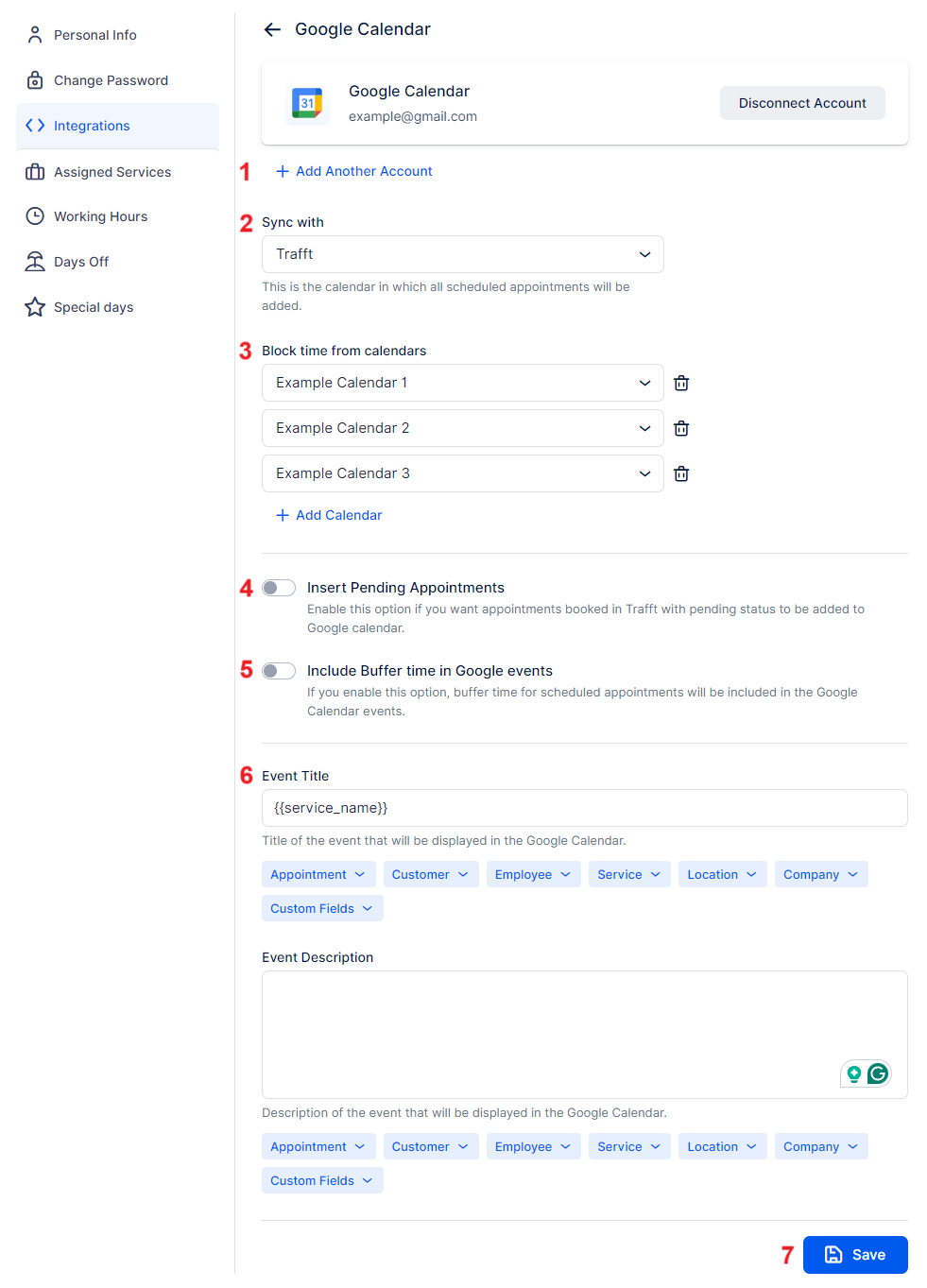
Google Meet
Google Meet integration must be enabled globally under Features & Integrations > Google Calendar > Set Up. Once enabled, Google Meet links are added to appointments automatically.
Check employee Working Hours and Service settings to ensure the service is available online or at all locations; otherwise, Meet links won’t appear.
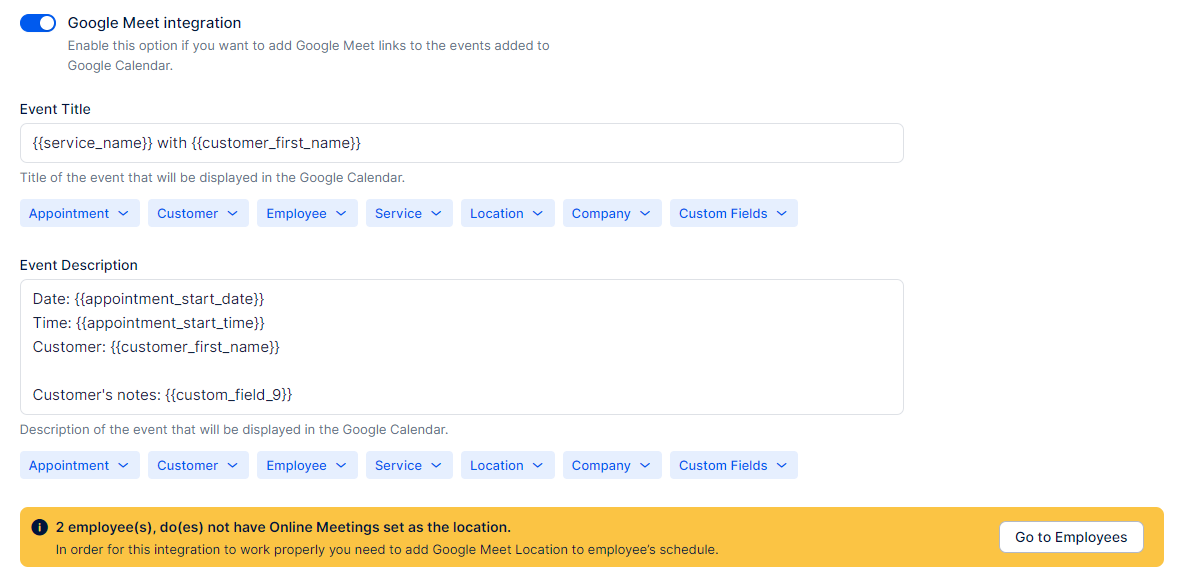
Once you access the "Employees" section, click on the three-dots menu next to the employee you want to edit -> Edit Employee. Once you access the employee's profile you'll be able to change the employee's default location and select Google Meet:
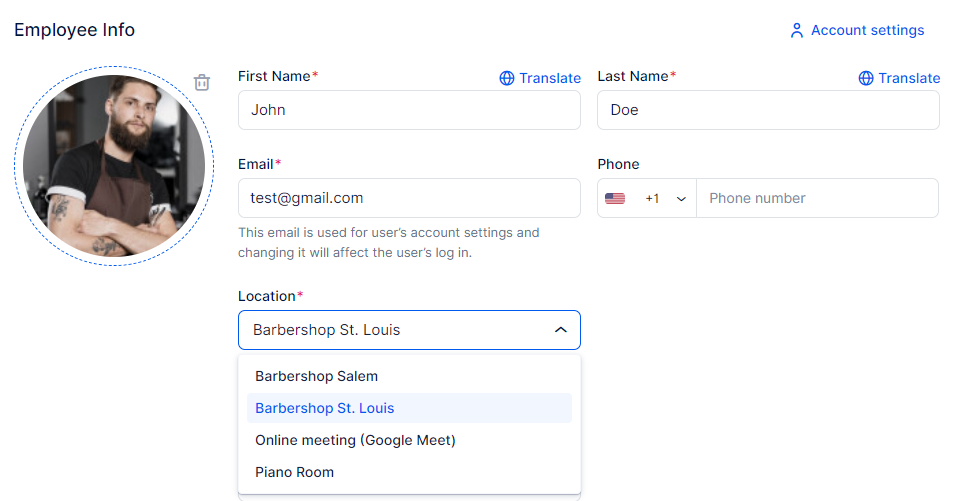
Please note that this does not guarantee that this employee is already available for booking via Google Meet, since you need to check his Working Hours first, and where the Services are offered (Online, On-site, or All Locations).
Working Hours - while you're in the employee's profile, click on the "Working Hours" tab and check the schedule. Since the Working Hours are designed to provide flexibility, there is a chance that saving Google Meet as the default location is not enough, since you manually defined other locations in the working hours. Just like in the screenshot below:
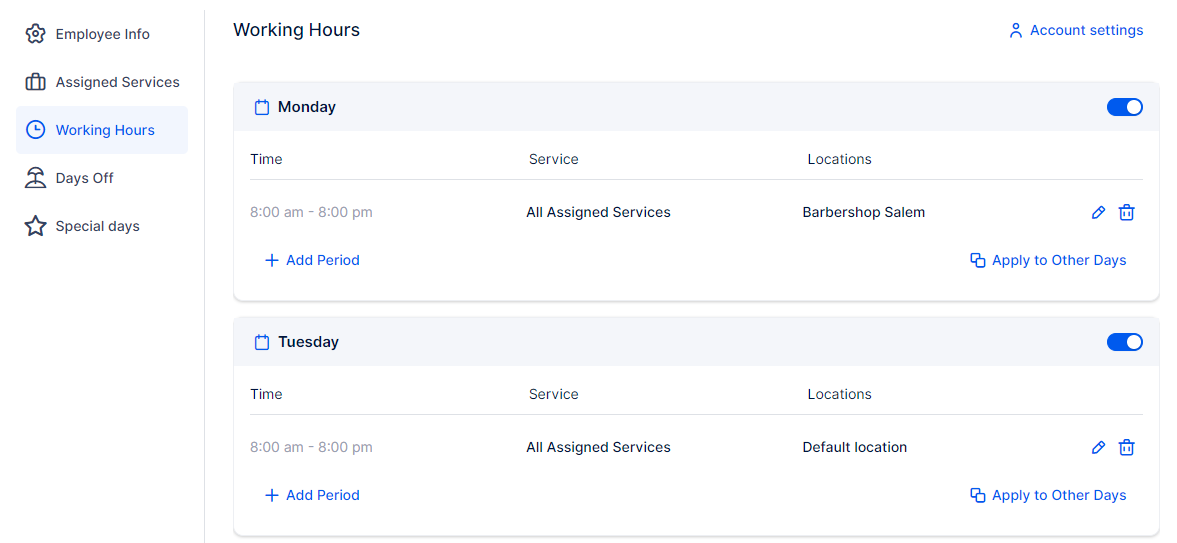
In this case, the employee will cover the Default Location (Google Meet) on Tuesdays, but Monday is configured for the "Barbershop Salem" location. Remember that you can select multiple locations during the employee's working hours and that you can create multiple working periods so the employee covers different locations per period.
Once you verify that the Working Hours of the employee are configured correctly, we can move on to Services.
Services - Access the Services section, and edit the service you want to offer via Google Meet. Within the service details, go to the "Settings" tab located in the left section and check the "Where do you want to provide the service" option.
"Online" and "All Locations" will allow the service appointments to be held via Google Meet, while "On-Site" will prevent this from happening.
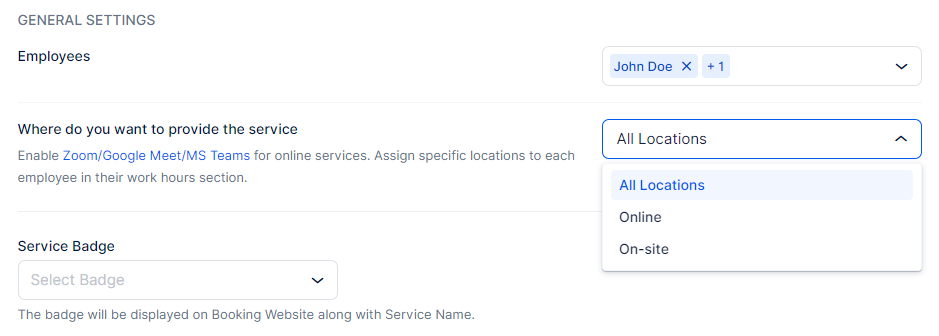
By verifying the employee's working hours and service availability, you are ready to use Google Meet.
When scheduling new appointments, a unique Google Meet URL will be created. Group Appointments will share the same URL for all participants. If "Send Event Invitation Email" is activated in your global Google Calendar and Google Meet settings, customers can accept the invitation. This will add the event, including the Google Meet link, along with the event's Title and Description from Trafft, to their Google Calendars.
Common Scenarios & Troubleshooting
Scenario 1: Employee connected only via Features & Integrations but still gets double bookings
Issue:
The employee is connected through the admin (F&I), but only one calendar is synced. They have other personal or work calendars with events that are not blocked, causing double bookings.
Solution:
- Remove the connection from Features & Integrations.
- Let the employee connect through Account Settings > Integrations > Google Calendar.
Scenario 2: Employee sees “Overridden by employee” message in Features & Integrations
Issue:
Admin sees this message when checking an employee’s calendar status.
What does it mean:
The employee is connected through Account Settings, so the admin cannot assign calendars from F&I.
Solution:
If you want to manage the calendar centrally, ask the employee to disconnect their Account Settings integration first.
Scenario 3: Employee wants to switch from an admin-managed to a self-managed connection
Issue:
The employee was connected via F&I but now needs to use multiple calendars.
Solution:
- Admin removes the existing connection from F&I (click X next to employee name).
- Employee reconnects via Account Settings and selects all needed calendars.
Scenario 4: Admin sees “You are already connected” in Account Settings
Issue:
Admin tries to connect via Account Settings but already has a calendar connected through F&I.
Solution:
- Disconnect from F&I first, then connect via Account Settings.
- Decide on one method to avoid conflicts.
Scenario 5: Employee connected but events are missing from Google Calendar
Issue:
Employee connected properly, but new bookings aren’t showing.
Possible causes and fixes:
- Check if the correct calendar is selected in Account Settings.
- Reconnect Google Calendar to refresh permissions.
- Ensure integration is enabled under F&I for that employee.
Key Points to Remember
This basically concludes and covers the Google Calendar integration, but here are the key points that are important in understanding how it works:
Have more questions
If you face an issue, and cannot find an answer in the documentation, feel free to submit a support ticket!
Contact us